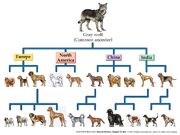
Science in Action Creating the Perfect Pet

Artificial Selection, or Selective Breeding in Dogs
Artificial selection is selective evolutionary pressure imposed by humans to obtain desired traits.
The term was coined by Darwin in contrast to his theory of Natural Selection, however the term used currently is known as Selective Breeding.
Artificial selection or Selective Breeding has been used for thousands of years for selecting traits in animals as well as agricultural plants and livestock.
Examples[]
A very good example of this can be seen in domesticated dogs. The variations in size and behavior of dogs has been shaped through artificial selection for the past 14,000 years (Akey et al., 2009).
There are now more than 400 breeds of dogs. As certain personality traits were selected for, such as submissiveness and agressiveness, or ability traits such as tracking or herding, other traits that are genetically linked to these traits were selected for as well. Careau, Reale, Murray and Thomas (2010) found a correlation between personality, energy expenditure, and longevity in the artifical selection of dogs.
A future study focuses on the genetic and phenotypic differences of purebred dogs vs. free range dogs to better understand the genetics of domestication and rapid adaptation (Boyko, 2014).
This video shows artifical selection going beyond selective breeding and into genetic engineering of cloning, which is a very controversial topic.

This emphasizes the idea that artificial selection is as simple as how some fish in a population have genes for being large in size and some have genes for being small. With that being said, the difference in size shows the variation in this given population. (http://evolution.berkeley.edu)
References[]
Akey, J. M., Ruhe, A. L., Akey, D. T., Wong, A. K., Connelly, C. F., Madeoy, J., ... & Neff, M. W. (2010). Tracking footprints of artificial selection in the dog genome. Proceedings of the National Academy of Sciences, 107(3), 1160-1165.
Boyko, A. R. (2014, January). Impact of Domestication and Artificial Selection on the Genetic Architecture of Canine Phenotypic Diversity. In Plant and Animal Genome XXII Conference. Plant and Animal Genome.
Careau, V., Réale, D., Humphries, M. M., & Thomas, D. W. (2010). The pace of life under artificial selection: personality, energy expenditure, and longevity are correlated in domestic dogs. The American Naturalist, 175(6), 753-758.